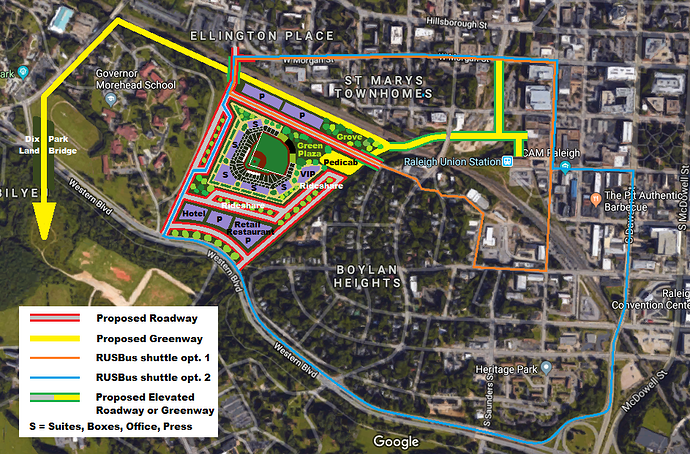So because this is a Raleigh discussion group and not a sports discussion group I’m going to divide this reply into two posts, this one dealing with some of the cities posited as examples of ballparks built on prime real estate. I’ll focus on Denver because it’s a very useful example, touch on the others, and then zero in on the lessons that would be applicable to Raleigh.
TLDR: Absolutely none of those ballparks were built on land that was prime real estate at the time the stadium was built.
Coors Field is in the LoDo section of Denver, which is north of the central business district, next to a railroad spaghetti junction, and was traditionally the warehouse district. By the 1980s, it had become essentially a skid row. Very few people lived there, and it was a place where locals generally wouldn’t want to be after dark. When Colorado got the Rockies in 1993, it had just started to show signs of life. Wynkoop Brewing opened in 1988, and like in a lot of places the gentrifying started with an arts and nightlife scene moving into the area to take advantage of ultra-low rents. Coors Field helped accelerate that renaissance, and the renovation of Union Station starting in 2012 was another big step forward. I realize that if you go there now, it looks like this amazing urban neighborhood, but that was most definitely not the case in 1993. Back then, it was probably the cheapest possible place they could have built the stadium.
So did Coors Field cause the revitalization of the neighborhood? That’s a debatable question. It was already just starting to get going, and over the last decade Denver has boomed so much that redevelopment is happening all over. Most likely, Coors Field helped attract development to LoDo that otherwise would have happened in other parts of Denver. (Nationals Park in Washington is an even more extreme example of this.)
Most of those other cities have similar stories. PNC Park was built on the north side of the Allegheny River, specifically because land was cheaper there. That’s actually why it has such a breathtaking vista of the central business district across the river. AT&T Park, which is the only modern ballpark built largely with private funding, has those great views of the Bay, but land there was actually cheaper because it was a relatively small footprint along the shore on the fringes of what was, at the time, a still-developing South Market neighborhood. Target Field is in a really cool location, at the intersection of a lot of transportation–there’s a commuter rail stop, the terminus of the light rail line, a bus station and a highway. But it’s actually separated from downtown proper by a massive interstate, and to get there by foot from downtown you have to cross a long pedestrian bridge over the freeway. It’s actually a great site for a stadium, but it wasn’t highly sought after land. Petco Park, again, is on the edge of town, near a railroad spaghetti junction, and was explicitly the centerpiece of a revitalization plan for the area. That famous Western Metal Supply Co. Building that was built into the stadium had been vacant for decades before the stadium was built. Busch Stadium in St. Louis is built in the parking lot of the old stadium, which was also conceived explicitly as an urban revival project in its day. Cincinnati is maybe the closest to being like what you’re describing, since it is very close to the CBD, but again, it’s on the “wrong” side of I-71.
The closest thing Raleigh would have to a site like these examples cited above is probably the site of the old Cargill plant that is going to be redeveloped soon. And that would be a really great site for a ballpark, from the perspective of a baseball team. (On top of everything else, the permanent lack of a north-south artery to convey traffic to the current Central Prison site actually makes it a suboptimal site for a baseball stadium.) But there are so, so few sites like that in Raleigh that a stadium proposal would face tons of competition for that land, which developers are practically salivating over.
Looking out a little further long-term, the Penmarc area would have some of the same characteristics as some of the successful examples cited above. Sure, it feels out-of-the-way now, but it won’t in a decade or so. Even longer term, the NCCIW site could have promise. But trying to build a baseball stadium on land that is already a prime candidate for redevelopment is not going to be a viable option because the economics of it simply don’t work. You’ve got to look for land that’s not currently sought after and develop into a destination site. And right now, there are very few places like that in Raleigh, and a lot of competition for the few that do exist.

 and pitching an idea that should be given true consideration by the city. Imho
and pitching an idea that should be given true consideration by the city. Imho 